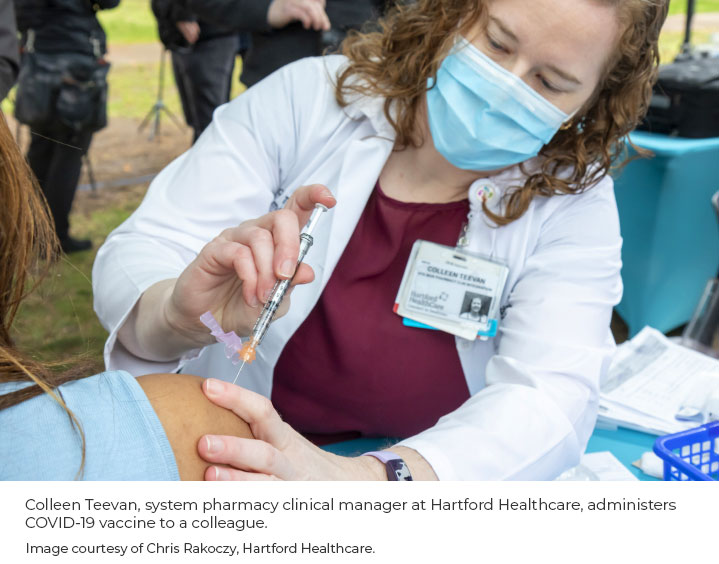

Pharmacists on Front Lines of Vaccine Rollout
Hartford Healthcare’s first shipment of COVID-19 vaccine arrived Monday, Dec. 14, and pharmacists are helping to administer the vaccine to the Connecticut health system’s frontline workers.
“We’re excited to be able to have pharmacists participating in giving these vaccines and really playing a huge role,” said System Pharmacy Clinical Manager Colleen Teevan. “We have at least 50 pharmacists from across our health system who right away volunteered and said, ‘I will help you vaccinate.’”
Teevan said Hartford Healthcare’s initial allocation of BNT162b2, an investigational mRNA COVID-19 vaccine from Pfizer Inc. and BioNTech SE, consisted of 1,950 doses for use at the health system’s seven acute care hospitals.
Once the health system received the tracking number for the vaccine shipment, staff members anxiously checked for updates as the package moved closer to its destination. The shipment arrived about three hours earlier than expected.
“Everyone was so happy that we have something to help us get through this and get back to, hopefully, a more normal situation,” she said. “Everybody is so excited to come and get the vaccine.”
She said Dec. 17 that not even the midweek Nor’easter that brought heavy snowfall to the state dampened the staff’s enthusiasm.
“We’re vaccinating healthcare workers who are already at work,” Teevan noted. “Our pharmacists made sure that they were able to get in to help with dispensing. And so we still have hundreds of people that we’re vaccinating today, despite the snow.”
Teevan said each vaccine clinic is staffed by occupational health nurses and at least one pharmacist, which helps alleviate the burden on the nurses.
“Right now, our hospitals are surging with COVID patients again. And so pretty much all the nurses are taking care of patients,” Teevan explained. She said the employee health nurses are also very busy tracking and managing staff exposures to SARS-CoV-2.
Teevan said the workflow at the COVID-19 vaccination clinic sites resembles an influenza vaccination clinic, but the appointments are more spaced out to better keep staff physically separate. And walk-ins aren’t allowed.
One early lesson is that extra care is needed to track appointments and ensure the pharmacy prepares and delivers the exact number of doses needed at each site.
“Timing is definitely a consideration,” Teevan said. “As we go through our first week of clinics, we’re kind of adjusting as we need to and making sure, if too many doses get sent to a site, that we’re able to move them somewhere else that they’ll get used before they expire. Because the last thing we want to do is to be wasting any doses.”
She said the health system’s staff members are aware of reports of serious allergic reactions that have occurred during the initial vaccine rollout.
“We’re being very transparent about the side effects,” Teevan said. “We have an allergic reaction kit onsite at every clinic that we’re doing, so that in the event that anything were to occur, we’re prepared to be able to address it right away.”
The first vaccine allocation didn’t cover everyone on staff who wanted to be vaccinated. Teevan said the health system prioritized frontline workers at greatest risk of exposure to SARS-CoV-2, including emergency department pharmacists and pharmacy technicians.
“Most of the other pharmacists will be probably in the second round,” she said.
News reports have stated that overfill in some vaccine vials is allowing recipients to eke out more 0.3 mL doses than the expected five per vial. Teevan said that’s been the case for her health system.
“We’re able to get six doses out of almost every vial. That was a great surprise,” she said.The Food and Drug Administration has urged healthcare providers to use all full doses in each vial. But the agency warned against pooling material from multiple vials of the preservative-free vaccine to obtain additional doses.
Teevan said her health system expects the state to send an additional allotment of BNT162b2 to cover the vaccine’s two-dose schedule.
“So we’re not holding it back, we’re trying to vaccinate everybody that we have a dose for in the first allocation. And we are making sure to have people schedule their appointments pretty much immediately so that they’re there and they’re ready and they don’t forget to come back,” she said.
During a press conference last week, the health system likened the arrival of COVID-19 vaccine to a moon landing.
“I think it is that big of a deal,” Teevan said. “We’ve been dealing with this pandemic for the past nine months. And we finally have something that will help us get through to the other side of it.”
For more information and free tools regarding the pandemic, including the Assessment of Evidence for COVID-19-Related Treatments, visit ASHP’s COVID-19 Resource Center and the COVID-19 Community at ASHP Connect.







